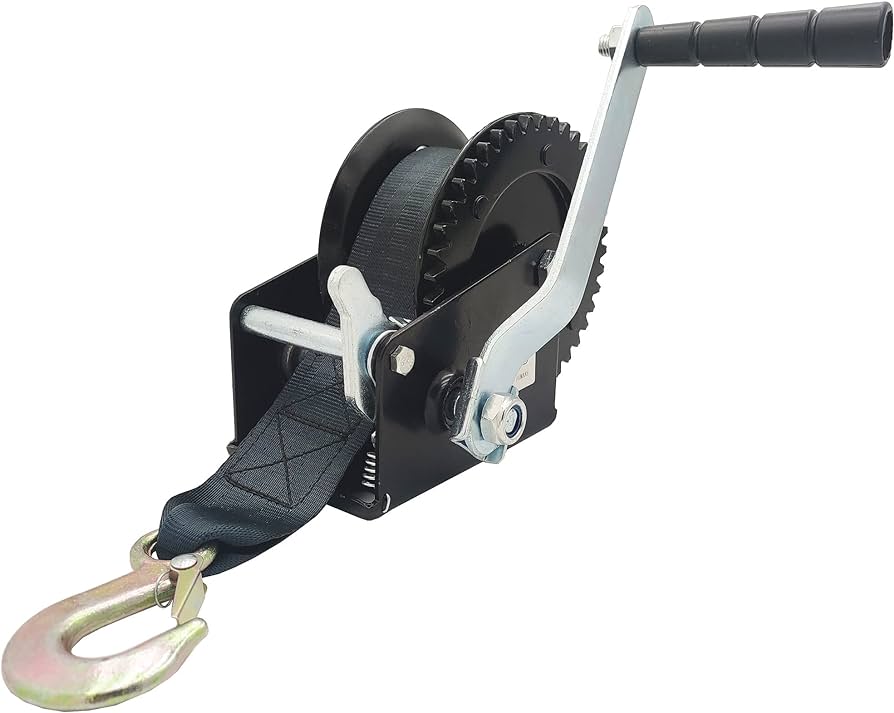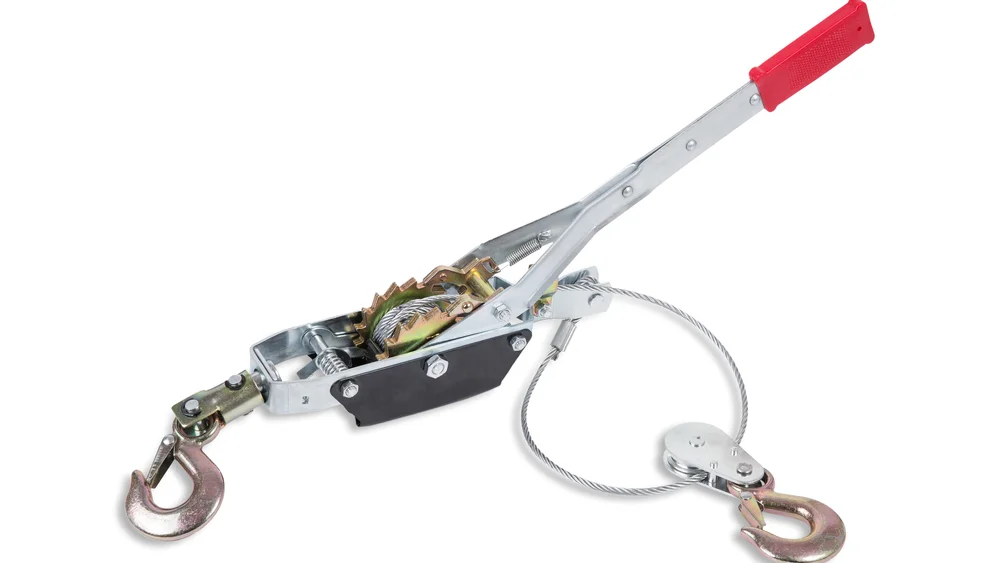When it comes to lifting and pulling heavy loads, having the right tools can make all the difference.
Two of the most popular options are hand winches and come alongs, but understanding their unique features and capabilities is crucial to ensure you choose the best tool for the job.
In this article, we’ll explore the differences between these two devices and help you determine which one is better suited for your lifting needs.
Hand Winch Overview

A hand winch is a mechanical device designed to lift or pull heavy loads by winding a cable or strap around a drum or spool. Hand winches come in various types, including cable winches, strap winches, and ratchet winches.
They rely on a combination of gears and a crank handle to provide a mechanical advantage, allowing the user to exert greater force on the load.
Advantages of hand winches include:
- Higher lifting capacity: Hand winches can typically handle heavier loads compared to come alongs.
- Better control: The gearing system and crank handle provide more precise control over the load’s movement.
- Versatility: Hand winches can be used for a wide range of applications, from construction sites to industrial settings.
Disadvantages of hand winches include:
- Bulkier size: Hand winches are generally larger and heavier than come alongs, making them less portable.
- Higher cost: Due to their more complex design and higher load capacity, hand winches tend to be more expensive.
- Limited portability: While some hand winches are designed to be more portable, they are generally less mobile than come alongs.
Come Along Overview

A come along, also known as a hand puller or cable puller, is a compact and portable tool used for pulling or stretching heavy loads over shorter distances.
Come alongs typically consist of a ratchet mechanism, a cable or strap, and a hook or anchor point.
They work by gripping the cable or strap and allowing it to be pulled through the ratchet mechanism, providing a mechanical advantage.
Advantages of come alongs include:
- Compact size: Come alongs are small and lightweight, making them highly portable and easy to store.
- Portability: Their compact design allows come alongs to be easily transported and used in various locations.
- Lower cost: Come alongs are generally more affordable than hand winches, making them an economical option for light-duty tasks.
Disadvantages of come alongs include:
- Lower lifting capacity: Come alongs have a lower weight capacity compared to hand winches, limiting their use for heavier loads.
- Potential slippage: The cable or strap can potentially slip under heavy loads, causing safety concerns.
- Limited control: Come alongs offer less precise control over the load’s movement compared to hand winches.
Comparison: Hand Winch vs. Come Along
When delving into the key aspects that differentiate hand winches from come alongs, it’s essential to analyze several critical factors: lifting capacity, ease of use, portability, cost, and safety.
These factors significantly influence the suitability of each tool for various tasks, impacting decision-making for those needing to lift or pull heavy objects.
Lifting Capacity and Control
Hand winches excel in lifting capacity. They are engineered to handle heavy loads, often exceeding what come alongs can manage.
This capability makes hand winches a go-to choice for industrial applications, construction projects, and any scenario requiring the movement of particularly heavy items.
The mechanism of a hand winch allows for more precise control over the load. Users can adjust the tension and position of the winch cable with greater accuracy, ensuring that heavy objects are lifted and moved safely and efficiently.
In comparison, come alongs, while capable of handling significant loads, usually have a lower maximum lifting capacity.
They are designed for lighter-duty tasks, making them less suitable for industrial or heavy construction needs but perfect for situations requiring quick adjustments and mobility, such as vehicle recovery or small-scale farm tasks.
Ease of Use and Portability
Come alongs are known for their ease of use and portability. Their design focuses on simplicity and mobility, allowing users to quickly set up and operate the tool with minimal effort.
This makes come alongs especially useful in scenarios where speed and ease of movement are priorities, such as roadside assistance or temporary repairs where a quick solution is necessary.
Hand winches, on the other hand, while offering more power and control, can be more complex to set up and operate.
Their bulkier design and the need for a stable mounting point or frame can make them less convenient for tasks that require quick, on-the-go solutions.
Cost and Affordability
Regarding cost, come alongs generally present a more affordable option compared to hand winches.
The simpler design and lower lifting capacity of come alongs contribute to their cost-effectiveness, making them an attractive option for individuals and businesses looking for a cost-efficient solution for light to medium lifting tasks.
Hand winches, with their more robust construction and higher capacity, tend to be more expensive. However, the investment reflects their durability, higher performance, and the ability to handle more demanding tasks, justifying the higher price for those requiring the tool’s added capabilities.
Safety Considerations
Safety is a paramount concern when lifting or pulling heavy objects. Hand winches offer superior control, reducing the risk of sudden movements or slippage that could lead to accidents.
The precise control mechanisms allow for smooth operation, minimizing the chances of injury or damage to the load.
Come alongs, while generally safe when used correctly, may present higher risks in certain situations due to their potentially lower control and stability, especially under maximum load.
Proper usage, including adherence to weight limits and operational guidelines, is crucial to ensure safety.
Applications and Use Cases
Applications of Hand Winches
Hand winches are designed for heavy-duty lifting tasks where precision, power, and control are paramount. Their robust construction and higher lifting capacity make them indispensable in several demanding environments:
- Construction Sites: On construction sites, heavy materials such as lumber, steel beams, and concrete blocks need to be moved and lifted regularly. Hand winches provide the necessary strength and control to maneuver these materials safely, reducing the risk of accidents and improving efficiency.
- Industrial Settings: In factories and warehouses, hand winches are used to lift and position heavy machinery, equipment, and large cargo. The precision control offered by hand winches is critical in these settings, where even slight misalignment can cause operational issues or damage valuable assets.
- Boating and Marine Applications: Hand winches are also used in boating and marine settings to lift heavy anchors or to haul boats onto trailers. The corrosive marine environment demands durable and reliable equipment, qualities that high-quality hand winches possess.
- Theater and Stage Setups: In the entertainment industry, hand winches play a role in lifting and positioning heavy set pieces and lighting equipment. The ability to control the speed and positioning precisely is crucial for the safety and aesthetic requirements of stage setups.
Applications of Come Alongs
Come alongs, with their portability and ease of use, are better suited for tasks that require quick setup and are on the lighter side of the lifting spectrum:
- Automotive Repairs: For vehicle repairs, especially in roadside or off-road situations, come alongs can be used to pull vehicles from ditches, assist in the alignment of body panels, or apply tension when needed. Their compact size and ease of operation make them a handy tool for many automotive enthusiasts and professionals.
- Farm Work: In agricultural settings, come alongs are useful for a variety of tasks, such as tensioning fencing, moving small equipment, or assisting in the lifting of light to medium loads. The tool’s portability allows it to be easily carried across large farm properties.
- Home and Garden Projects: For DIY enthusiasts, come alongs can be invaluable for landscaping projects, moving large plants or rocks, and a host of other tasks where a relatively light yet forceful pulling action is needed.
- Emergency Situations: Due to their compact nature, come alongs can be an essential tool in emergency kits for off-roaders, campers, and hikers. They can be used for self-rescue if a vehicle becomes stuck or to clear pathways of fallen trees and debris.
Conclusion
Both hand winches and come alongs are valuable tools for lifting and pulling heavy loads, but their suitability depends on the specific task at hand.
Hand winches are ideal for heavy-duty lifting and pulling applications that require greater control and precision, while come alongs are better suited for light-duty pulling tasks and situations where portability and affordability are priorities.
Ultimately, the choice between a hand winch and a come along should be based on factors such as the weight of the load, the distance it needs to be moved, the environment in which the tool will be used, and your budget constraints.
If you’re unsure about which tool is best for your needs or if you’re tackling a particularly complex or high-risk lifting task, it’s always advisable to consult with professionals or seek expert advice to ensure safe and efficient operations.

